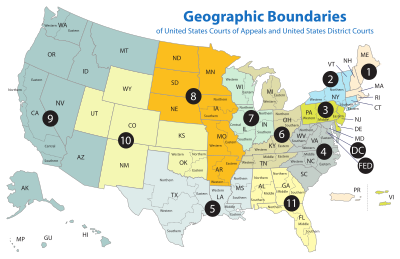Establishment and Structure of District Courts
– District courts were established by Congress through the Judiciary Act of 1789.
– The U.S. Constitution does not require the existence of district courts.
– State courts retain concurrent jurisdiction in most federal matters.
– Each state, the District of Columbia, and Puerto Rico have at least one judicial district.
– Most states with three districts add a Middle District, except for Illinois and Oklahoma.
– New York, Texas, and California have four districts, each with unique designations.
– The number of judges in each district court is set by Congress.
– District judges, except for territorial courts, are appointed for life.
– Involuntary removal of a judge can only occur through impeachment.
– Impeachment requires a conviction by a two-thirds vote in the Senate.
– Judges can retire at the age of 65 or if they become disabled.
– The district court appoints a clerk who oversees filings, maintains records, processes fees, and manages the court’s non-judicial work.
– Minimum 10 years of administrative experience required to serve as a clerk.
– District courts have original jurisdiction over various types of cases.
– Attorneys must be admitted to the bar of the district court.
– Final rulings by district courts can be appealed to the court of appeals.
Other Federal Trial Courts
– The United States Court of International Trade handles international trade and customs issues.
– The United States Court of Federal Claims has exclusive jurisdiction over most claims against the U.S.
– The United States Tax Court deals with contested pre-assessment determinations of taxes.
Judges and Tenure
– District court judges are officially titled United States District Judges.
– Other federal judges can also sit in a district court upon assignment.
– Magistrate judges are appointed by each district court and serve for eight-year terms.
– Only twelve judges have been impeached in U.S. history, with seven being removed.
Appeals and Jurisdiction
– Some specialized matters must be appealed to the Court of Appeals for the Federal Circuit.
– Direct appeal to the Supreme Court is possible in very few cases.
– Federal courts have limited jurisdiction and Congress must grant subject matter jurisdiction for district courts to hear cases.
– Jurisdiction is concurrent with state courts for most cases.
– Removal to federal court is possible in certain cases.
District Court System and Caseload
– District courts are integrated within the federal court system.
– District courts have a relationship with other federal courts.
– Appeals process from district courts to circuit courts.
– District court caseload and its impact on the judicial system.
– Importance of district courts in the administration of justice.
The United States district courts are the trial courts of the U.S. federal judiciary. There is one district court for each federal judicial district, which each cover one U.S. state or, in some cases, a portion of a state. Each district court has at least one courthouse, and many districts have more than one. District courts' decisions are appealed to the U.S. court of appeals for the circuit in which they reside, except for certain specialized cases that are appealed to the U.S. Court of Appeals for the Federal Circuit or directly to the U.S. Supreme Court.

District courts are courts of law, equity, and admiralty, and can hear both civil and criminal cases. But unlike U.S. state courts, federal district courts are courts of limited jurisdiction, and can only hear cases that involve disputes between residents of different states, questions of federal law, or federal crimes.
1912 NW 143rd Ave #24,
Portland, OR 97229, USA